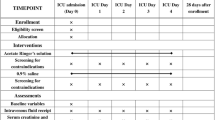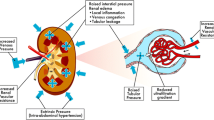Abstract
Background
The use of chloride-rich crystalloids for resuscitation is associated with acute kidney injury (AKI). We aimed to explore the impact of resuscitation with chloride-rich crystalloids compared to balanced crystalloids on kidney function recovery in patients presenting with sepsis-associated community-acquired AKI (SACA-AKI).
Methods
This is a single-center, historical cohort study of the adult intensive care unit (ICU) patients who presented to the emergency department (ED) with sepsis-associated community-acquired-AKI at the Mayo Clinic, Rochester, MN, from January 2011 to April 2018. We divided the cohort into two groups based on the primary type of crystalloids they received in the ED and the first 48-h of ICU. The first group received primarily normal saline with < 25% balanced solutions, and the second group received at least ≥ 25% balanced crystalloids during the initial volume resuscitation.
Results
Among the 732 enrolled patients [mean age: 64 ± 17, males: 461(63%)], 255 (35%) were in the second group and were found to have higher positive fluid balance during the first 48-h of admission compared to the first group [median + 2.3 (IQR: 0.4; 4.5) vs. + 1.1 (IQR: − 0.8; + 2.9) L, p < 0.001]. The second group had a higher rate of kidney function recovery by multivariate logistic regression after adjustments for known recovery risk factors (OR 1.46; 95% CI 1.05–2.04, p = 0.02).
Conclusions
The use of balanced crystalloids during the initial resuscitation is associated with higher odds of kidney function recovery in AKI patients with sepsis-associated community-acquired AKI.
Graphic abstract


Similar content being viewed by others
References
Lewington AJ, Cerda J, Mehta RL (2013) Raising awareness of acute kidney injury: a global perspective of a silent killer. Kidney Int 84:457–467
Wonnacott A, Meran S, Amphlett B, Talabani B, Phillips A (2014) Epidemiology and outcomes in community-acquired versus hospital-acquired AKI. Clin J Am Soc Nephrol 9:1007–1014
Grams ME, Plantinga LC, Hedgeman E et al (2011) Validation of CKD and related conditions in existing data sets: a systematic review. Am J Kidney Dis 57:44–54
Hsu CN, Lee CT, Su CH et al (2016) Incidence, outcomes, and risk factors of community-acquired and hospital-acquired acute kidney injury: a retrospective cohort study. Medicine. 95:e3674
Talabani B, Zouwail S, Pyart RD, Meran S, Riley SG, Phillips AO (2014) Epidemiology and outcome of community-acquired acute kidney injury. Nephrology (Carlton, Vic.). 19:282–287
Tecson KM, Hashemi H, Afzal A, Gong TA, Kale P, McCullough PA (2019) Community-acquired acute kidney injury as a risk factor of de novo heart failure hospitalization. Cardiorenal medicine 9:252–260
Schissler MM, Zaidi S, Kumar H, Deo D, Brier ME, McLeish KR (2013) Characteristics and outcomes in community-acquired versus hospital-acquired acute kidney injury. Nephrology (Carlton, Vic.). 18:183–187
Pai AB, Divine H, Marciniak M et al (2019) Need for a judicious use of nonsteroidal anti-inflammatory drugs to avoid community-acquired acute kidney injury. Ann Pharmacother 53:95–100
Dreischulte T, Morales DR, Bell S, Guthrie B (2015) Combined use of nonsteroidal anti-inflammatory drugs with diuretics and/or renin-angiotensin system inhibitors in the community increases the risk of acute kidney injury. Kidney Int 88:396–403
Santos RPD, Carvalho ARS, Peres LAB, Ronco C, Macedo E (1992) An epidemiologic overview of acute kidney injury in intensive care units. Rev Assoc Med Bras 2019(65):1094–1101
Uchino S, Kellum JA, Bellomo R et al (2005) Acute renal failure in critically ill patients: a multinational, multicenter study. JAMA 294:813–818
Godin M, Murray P, Mehta RL (2015) Clinical approach to the patient with AKI and sepsis. Semin Nephrol 35:12–22
Bagshaw SM, George C, Bellomo R, Committee ADM (2008) Early acute kidney injury and sepsis: a multicentre evaluation. Crit Care 12:R47
Abdelsalam M, Elnagar SSE, Mohamed AH, Tawfik M, Sayed AN (2018) Community acquired acute kidney injury in mansoura nephrology dialysis unit: one year prospective observational study. Nephron 140:185–193
Griffin BR, Liu KD, Teixeira JP (2020) Critical Care Nephrology: Core Curriculum 2020. Am J Kidney Dis 75:435–452
Kellum JA (2018) Abnormal saline and the history of intravenous fluids. Nat Rev Nephrol 14:358–360
Kaplan LJ, Frangos S (2005) Clinical review: Acid-base abnormalities in the intensive care unit – part II. Crit Care 9:198–203
Omron EM, Omron RM (2010) A physicochemical model of crystalloid infusion on acid-base status. J Intensive Care Med 25:271–280
Chawla LS, Bellomo R, Bihorac A et al (2017) Acute kidney disease and renal recovery: consensus report of the Acute Disease Quality Initiative (ADQI) 16 Workgroup. Nat Rev Nephrol 13:241–257
Yunos NM, Bellomo R, Glassford N, Sutcliffe H, Lam Q, Bailey M (2015) Chloride-liberal vs. chloride-restrictive intravenous fluid administration and acute kidney injury: an extended analysis. Intensive care medicine. 41:257–264
Yunos NM, Bellomo R, Hegarty C, Story D, Ho L, Bailey M (2012) Association between a chloride-liberal vs chloride-restrictive intravenous fluid administration strategy and kidney injury in critically ill adults. JAMA 308:1566–1572
Finfer S, Liu B, Taylor C et al (2010) Resuscitation fluid use in critically ill adults: an international cross-sectional study in 391 intensive care units. Crit Care 14:R185
Neyra JA, Canepa-Escaro F, Li X et al (2015) Association of Hyperchloremia With Hospital Mortality in Critically Ill Septic Patients. Crit Care Med 43:1938–1944
Raghunathan K, Shaw A, Nathanson B et al (2014) Association between the choice of IV crystalloid and in-hospital mortality among critically ill adults with sepsis*. Crit Care Med 42:1585–1591
Kellum JA, Lameire N, Aspelin P et al (2012) Kidney disease: improving global outcomes (KDIGO) acute kidney injury work group. KDIGO clinical practice guideline for acute kidney injury. Kidney Int Supplements 2:1–138
Shankar-Hari M, Phillips GS, Levy ML et al (2016) Developing a New Definition and Assessing New Clinical Criteria for Septic Shock: For the Third International Consensus Definitions for Sepsis and Septic Shock (Sepsis-3). JAMA 315:775–787
Palevsky PM, Molitoris BA, Okusa MD et al (2012) Design of clinical trials in acute kidney injury: report from an NIDDK workshop on trial methodology. Clin J Am Soc Nephrol 7:844–850
Der Mesropian PJ, Kalamaras JS, Eisele G, Phelps KR, Asif A, Mathew RO (2014) Long-term outcomes of community-acquired versus hospital-acquired acute kidney injury: a retrospective analysis. Clin Nephrol 81:174–184
Soto K, Campos P, Pinto I et al (2016) The risk of chronic kidney disease and mortality are increased after community-acquired acute kidney injury. Kidney Int 90:1090–1099
Bellomo R, Kellum JA, Ronco C et al (2017) Acute kidney injury in sepsis. Intensive Care Med 43:816–828
Hjortrup PB, Haase N, Bundgaard H et al (2016) Restricting volumes of resuscitation fluid in adults with septic shock after initial management: the CLASSIC randomised, parallel-group, multicentre feasibility trial. Intensive Care Med 42:1695–1705
Hu B, Chen JCY, Dong Y et al (2020) Effect of initial infusion rates of fluid resuscitation on outcomes in patients with septic shock: a historical cohort study. Crit Care 24:137
Chen JCY, Hu B, Frank RD, Kashani KB (2020) Inpatient Kidney Function Recovery among Septic Shock Patients Who Initiated Kidney Replacement Therapy in the Hospital. Nephron 144:363–371
Finfer S, Bellomo R, Boyce N et al (2004) A comparison of albumin and saline for fluid resuscitation in the intensive care unit. N Engl J Med 350:2247–2256
Caironi P, Tognoni G, Masson S et al (2014) Albumin replacement in patients with severe sepsis or septic shock. N Engl J Med 370:1412–1421
Semler MW, Self WH, Wanderer JP et al (2018) Balanced Crystalloids versus Saline in Critically Ill Adults. N Engl J Med 378:829–839
Shaw AD, Raghunathan K, Peyerl FW, Munson SH, Paluszkiewicz SM, Schermer CR (2014) Association between intravenous chloride load during resuscitation and in-hospital mortality among patients with SIRS. Intensive Care Med 40:1897–1905
Brown RM, Wang L, Coston TD et al (2019) Balanced Crystalloids versus Saline in Sepsis. A secondary analysis of the SMART Clinical Trial. American journal of respiratory and critical care medicine. 200:1487–1495
Gomez H, Ince C, De Backer D et al (2014) A unified theory of sepsis-induced acute kidney injury: inflammation, microcirculatory dysfunction, bioenergetics, and the tubular cell adaptation to injury. Shock 41:3–11
Hammond DA, Lam SW, Rech MA et al (2020) Balanced Crystalloids Versus Saline in Critically Ill Adults: A Systematic Review and Meta-analysis. Ann Pharmacother 54:5–13
Lameire NH, Bagga A, Cruz D et al (2013) Acute kidney injury: an increasing global concern. Lancet 382:170–179
Acknowledgements
We would like to thank Dr. Juan Pablo Domecq Garces and Dr. Kimberly R. Johnson for their support. This project was supported in part by the National Institute of Allergy and Infectious Diseases of the National Institutes of Health under Award Number K23AI143882 (PI; EFB).
Author information
Authors and Affiliations
Corresponding author
Ethics declarations
Conflict of interest
None of the authors has any conflict of interest related to the topic of this article.
Ethical approval
This study has been reviewed and approved by the local Institutional Review Boardand. This study is conducted in accordance with the ethical standards laid down in the 1964 Declaration of Helsinki and its associated amendment.
Additional information
Publisher's Note
Springer Nature remains neutral with regard to jurisdictional claims in published maps and institutional affiliations.
Rights and permissions
About this article
Cite this article
Tehranian, S., Shawwa, K., Barreto, E.F. et al. Impact of chloride-rich crystalloids on sepsis-associated community-acquired acute kidney injury recovery in critically ill patients. J Nephrol 35, 285–292 (2022). https://doi.org/10.1007/s40620-021-01060-8
Received:
Accepted:
Published:
Issue Date:
DOI: https://doi.org/10.1007/s40620-021-01060-8




